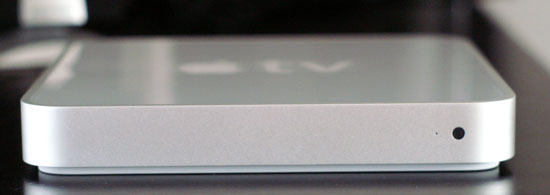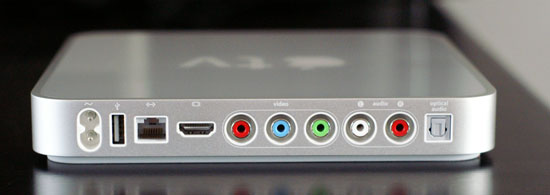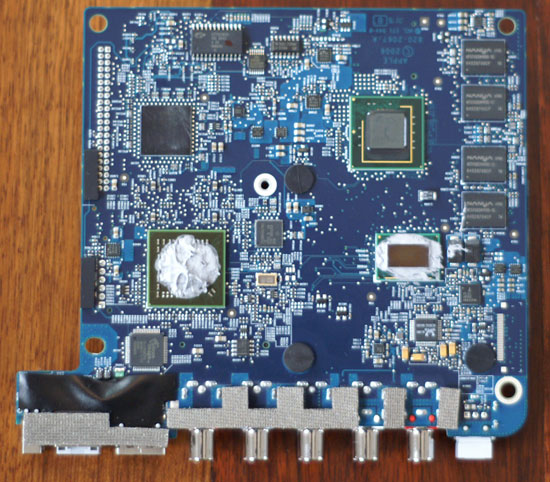Apple TV - Part 2: Apple Enters the Digital Home
by Anand Lal Shimpi on March 26, 2007 1:22 AM EST- Posted in
- Mac
Touch it, Bring it
The Apple TV is a low profile device, measuring 7" on each side and only 1.1" high. It's not going to do a good job blending with other home theater components as it is distinctly Apple; it looks a lot like a thinner, flattened Mac mini.

In traditional Apple style the device's form is very simple, there's not so much as a power button on the unit. On the front you've got an IR receiver for the remote and a single power/activity LED. When the system is booting the LED blinks amber, when ready for use it's solid white, and each time it receives a command from the remote it blinks.
The sides of the unit are bare and in the back you've got a row of ports. Given the target market for the unit, Apple went with strictly modern video outputs. The Apple TV only works via HDMI, component or DVI outputs (the latter through an HDMI to DVI converter). Apple doesn't provide you with any cables other than the power cord, so your choice of output will be met with an additional expense to buy the cable.

Complementing the HDMI and component video outputs are two audio outputs: stereo RCA and optical. Of course if you run HDMI to your display you don't need another cable for audio.
What powers the Apple TV? If you read Part 1 of our coverage we discovered that the unit is powered by an Intel Pentium M based on the Dothan core. The ultra low voltage (ULV) Pentium M runs at 1GHz with a 400MHz FSB and features a 2MB L2 cache. Apple chose Intel's 945G chipset but the graphics output is driven by an NVIDIA GeForce Go 7300. The Apple TV currently ships with 256MB of DDR2 system memory and 64MB of GDDR3 for the NVIDIA GPU.

The unit ships with a 40GB 2.5" PATA drive, and our Apple TV happened to use a 4200RPM Fujitsu drive. Upgrading the hard drive appears trivial; a simple swap should suffice, though of course you'll have to copy the contents of the disk over first. The Apple TV's integrated 802.11n wireless is driven by a Broadcom mini-PCI card inside the device; Realtek powers the built in 10/100 Ethernet.
A quick rundown of the specifications paints Apple TV as a notebook without a screen, and a fairly powerful one at that, given the target market. For a box that is only going to be playing relatively light content, Apple made sure it was more than powerful enough.










48 Comments
View All Comments
Hulk - Monday, March 26, 2007 - link
Great review by Anand as usual but a very disappointing product.No native 1080p and not H.264 at higher resolutions and bitrates makes it useless for me to even consider.
No thanks I'll just build a HTPC that actually plays back high quality, high resolution video and has loads of storage.
sprockkets - Monday, March 26, 2007 - link
But a mini itx with a AM2 or new via processor with a tuner card is almost as small and more useful. And much more expensive.Phynaz - Monday, March 26, 2007 - link
DivX support was hacked in last week.BladeVenom - Monday, March 26, 2007 - link
Coming out with a device that doesn't play 99.99% of the videos available just doesn't make any sense to me. If you want to hook a TV to your computer get a $30 cable, not a $300 box that doesn't even play the most common formats.rrsurfer1 - Monday, March 26, 2007 - link
Well I have an old xbox, not 360, the first version, that does better as a media extender than this. Of course it has a modchip, but still, it has basically none of the flaws discussed here and it costs a hell of a lot less. I've had almost no issues with it, and it plays everything I want it to.BoberFett - Monday, March 26, 2007 - link
With the ease of soft mods these days, the Xbox with XBMC is still the best thing going. Under $100 for a used Xbox, and the only thing it lacks that I can see is hi def. And since it sounds like the Apple TV only supports HD somewhat (limited bitrates, no 1080p) it isn't as good as the Xbox, especially when you consider all the extra functionality the Xbox has as a game machine, DVD player, emulation box, etc. The Xbox also isn't limited to streaming from a host machine using iTunes or Windows MCE. Perhaps someday the PS3 or 360 will be properly cracked and step into that role, but for now I'm sticking with XBMC on the original Xbox.dugbug - Monday, March 26, 2007 - link
Why are folks holding their punches with this product? Anand, you should not be gentle with products just to appease the applenauts. This thing is $300 and offers hardly any value.Media center and tivo both destroy the thing so utterly. I am more than shocked as well with how well the xbox 360 works as an extender.
-d
Chadder007 - Monday, March 26, 2007 - link
Add 1080p supportAdd a way for users to somehow remote control their MAC from the Apple TV
Add support for more media types
somegeek - Monday, March 26, 2007 - link
Anand Shimpi CES '07: "Convergence Happened."No it didn't, and it never will.
"Convergence" is one of those horrible, ambiguous, buzz-words that are used by people who have no real ideas. "Convergent" devices will all fail because they're too expensive, too limited, too hard to use, too hard to make, and specialized devices are a lot more profitable and easier to sell. Set-top boxes and HTPCs have consistently been ignored by the mainstream and the AppleTV won't be any different. When new, divergent technology becomes mainstream, all the annoying "convergence" people will claim that's what they meant all along.
creathir - Monday, March 26, 2007 - link
Anand,You should also review the 360 with the Media Center in Vista. This setup is really quite simple, elegant, and addresses many of the issues you have with the AppleTV product. There are a few issues with codecs, as some of the more... questionable ones are not "natively" supported, but independent software developers out there have addressed these issues with transcoding add-ins that transcode on the fly. You really should check it out.
- Creathir